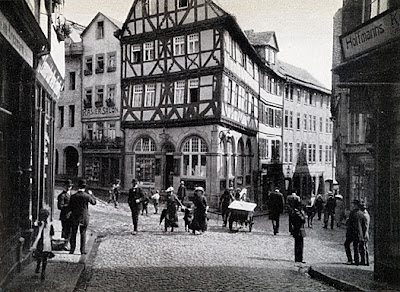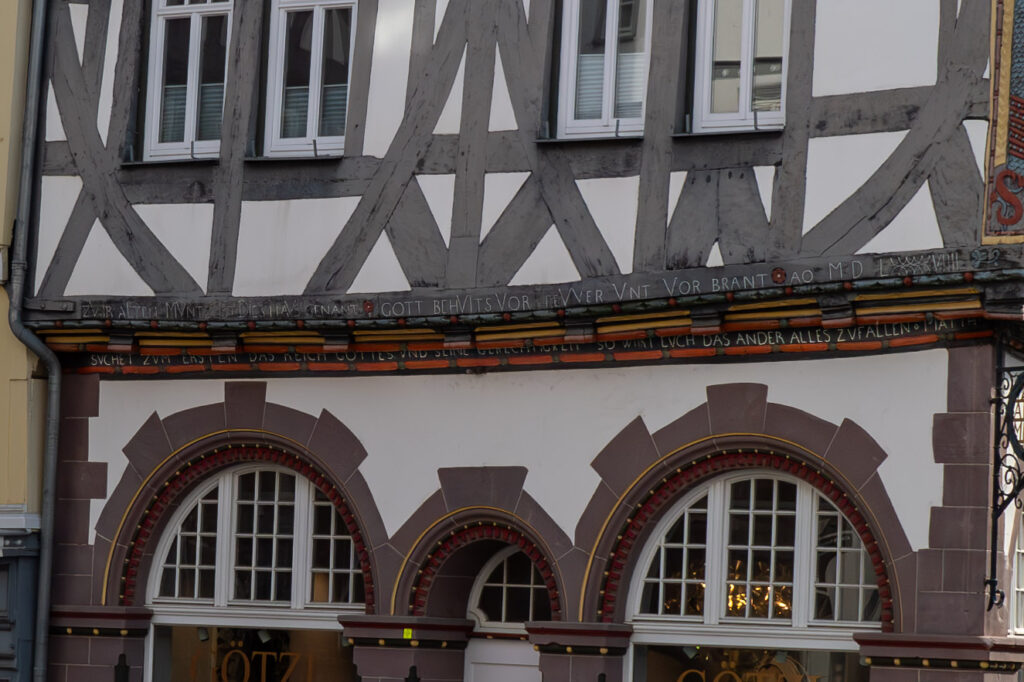No self-respecting Leica owner has visited the town of Wetzlar, some 75km north of Frankfurt, without attempting to reproduce Oskar Barnack’s iconic photograph of the Eisenmarkt. He snapped the marketplace, including the ancient structure known as The Old Mint, with the Ur Leica and a 42mm fixed Mikro Summar lens in 1914. It is said to be the first photograph ever taken with a Leica, although this is unlikely. But it is certainly one of the best known images among Leica aficionados, and we can feel ourselves fortunate that not much has changed in the past 110 years. This is still clearly the same location.



Many readers of Macfilos will be very familiar with the story of the Ur Leica and the background to this first picture (at least, the first picture we know about). Even seasoned visitors cannot resist the temptation to reproduce the famous shot and then crop it to look as near as possible to the original. But I make no apologies for regurgitating something so familiar to many readers. Be patient, because there will be new readers who don’t know the story.
Fortunately, finding the spot where Oskar Barnack took this photograph is now foolproof. No need to guess (because you’d probably guess wrong).
The Oskar Barnack commemorative ‘plaque’
In 2014, to mark the 100th anniversary of Barnack’s iconic snap, the mayor of Wetzlar inaugurated a commemorative person-hole (né manhole) cover which puts you right on the spot. No more excuses for being slightly off.
Dominating the scene before your lens is the fairy-tale 16th-century structure, Zur Alten Münze, named after the mint that previously occupied the site on the old “Iron Market”.
The opening photographs, above, show two shots side by side. On the left is Oskar Barnack’s original from the Ur Leica, on the right is my most recent attempt using the only camera I had with me, the Leica Q3 (or, as they say in those parts, the Ku-drei). The ku’s wider 28mm lens obviously offers a different perspective, although the overall impression is very similar.


For comparison, above is the full frame from the Q3, in colour for a change, which covers the wider area. The black-and-white shot below it, taken by our William Fagan five years ago, comes from a 35mm Summicron. William says he “tucked it in a bit” to try to make it more like the output from the 42mm Summar. For my Q3 shot, there was a great deal of tucking to be tucked.
Spot the difference
What is not immediately apparent from the latest Q3 shot is the result of 110 years of optical development. As Leica’s lens guru Peter Karbe never tires of telling us, the excellence of modern Leica lenses encourages cropping. Taking Peter’s advice, what can we see on the Old Mint house if we zoom in from my 2023 image? Quite a lot, as it happens.

While the left-hand side of the inscription somewhat difficult to decipher, the major part is easily recognised. It’s in 16th-century German, of course.
Original inscription
Zur alten Muntz ist dies Haus genannt / Gott behuts vor Fewer unt vor Brant AO MDLXXXXVIII
Modern German
Zur alten Münze ist dies Haus genannt / Gott behüt’s vor Feuer und vor Brand AO 1599
And then, in English:
This house is called The Old Mint / God protect it from fire. AD 1599
Of course, with a longer lens or a shorter distance between lens and subject, reading the carved words presents no problem. If you really wanted a record of that carving, you would make other arrangements. But, for a 28mm lens at such a distance, this is a remarkable testimony to the optical excellence of the f/1.7 Summilux — a lens that has remained unmodified since it was introduced on the first Leica Q in 2015.
A must-take image for Oskar Barnack fans
Finally, the picture of Eisenmarkt and the Old Mint House, has become something of a Leica cliché. It’s probably equivalent to having your photograph taken in front of a red London telephone kiosk or the so-called Big Ben. Yet, there are far fewer pictures taken the other way around, looking up the Brodschirmstraße in the direction of the Wetzlar cathedral. I did an about-turn on the cast iron to bring you the view from Eisenmarkt…

The old town of Wetzlar is delightful, and well worth a visit, even without the enticing prospect of touring the factory and visiting a Leica camera store or two. You can choose from the impressive company owned Leica Store on Leitz Platz (which is a larger version of your local example) or the far more interesting and individual Leica Store Wetzlar Altstadt. This is owned by one of the world’s foremost authorities on vintage Leicas, Lars Netopil. Find him near to Eisenmarkt at No.4 Baugasse. Check the opening times, though, which are mostly in the afternoons, Monday to Friday.
Have you been to Wetzlar and did you take The Picture? Or are you planning a visit to the Leica Factory in the near future? Better find a 42mm lens…
Join the Macfilos subscriber mailing list
Our thrice-a-week email service has been polished up and improved. Why not subscribe, using the button below to add yourself to the mailing list? You will never miss a Macfilos post again. Emails are sent on Mondays, Wednesdays, and Fridays at 8 pm GMT. Macfilos is a non-commercial site and your address will be used only for communications from the editorial team. We will never sell or allow third parties to use the list. Furthermore, you can unsubscribe at any time simply by clicking a button on any email.

From where I live it takes less than an hour by car to get to Wetzlar and I was there Wetzlar some years ago. I shot a roll of Tri-X (back at the time it was still affordable) but I also had the issue with the building site and had to fall back on another less iconic perspective. The picture of this well-known spot is definetly not the best one of the roll.
I agree with a Jörg-Peter. Wetzlar is a lovely place which is worth a trip. I still enjoy every know and then to look at the pictures I took during my trip.
I was also there a few years ago. There were construction works going on, so the photo turned out somewhat underwhelming. Otherwise, Wetzlar is a beautiful place with a nice park on the banks of the river Lahn and a well-preserved historic centre. Together with the Leica Welt well worth a visit, but do keep your hands firmly on the wallet. Many red dot temptations.
Mike, I forgot to mention that the “man hole cover” was facing the wrong way when they first installed it! If you stood reading it the right way, you had the subject of Barnack’s image behind you, facing your back. I remember pointing this out to someone at Leica, and eventually it was installed right way round. I am sure I was not the first person to realize this.
Also, when we visited the Eisenmarkt last year, everything was torn up, and we have pictures with a massive dirt pile with a small tractor on top of it. Glad everything has been put ship shape again!
Thanks Bill, and for your other comment. I’m glad they put Humpty Dumpty together again, otherwise I wouldn’t have got my picture.
On one of the occasions I was in Wetzlar, possibly for the opening of the Ernst Leitz Museum in 2021, the manhole cover had been removed and my heart sank. Now I know it was undergoing ‘re-orientation’, thanks to Bill! My 2014 photo of the cover, taken the day after the manhole had been inaugurated, must be a wrong direction image. It is all good clean fun, once somebody does not use AI to recreate the original Barnack image from 1914. Believe me, this will be an issue with all historical photographs in years to come.
William
Thanks, Mike. I have been to Wetzlar 6 times, but that is not near as many times as Bill Rosauer who told me that his first visit there was when he was just 16. I photographed this location on my first two visits to Wetzlar and, in truth, the second time around I should have brought a copy of the Barnack Photo as I’m not sure if that manhole cover is precisely where Barnack was. I have a pair of 42mm Mikro Summars, one of which dates from around the time that Barnack took his famous image. However, I don’t have a normal focus mount for the lenses and I am restricted to using them for close up work, using an adaptor called a Repro Summar, a task at which they perform admirably.
While we were in Wetzlar on this occasion, Bill and I went into the Leica Archive with an expert group, including Jim Lager, to examine many aspects of early and pre-Leica cameras. This included the factory records for such cameras and also boxes of negatives taken by Oskar Barnack and others in the early years from 1914 onwards. We are were trying to find out what type of film was used, whether it was orthochromatic or panchromatic or was of a special type such as the ‘fliegerfilm’ used on German reconnaissance aircraft. However, 35mm film back then was not a commercial product for consumer use and the sides of the film contain no indication of brand or type. We were also looking for evidence of whether yellow filters were being used, which is also difficult to determine. Perhaps the most interesting item we found was a panoramic image on a negative about the width of 3 x 35mm frames, probably taken by Barnack from a Zeppelin, about 1918, using an experimental panoramic camera which was ‘kept hidden from the Allies’. Some photographs of such a camera exist, but they are usually said to be from a later date.
We also examined the device called M875 from about 1912 which resembles a Leica, but which seems to have been a film tester for use in conjunction with Barnack’s 35mm cine camera. However, an examination of Barnack’s handwritten notebook led to no little debate on how exactly the device was used. The literal translation of Barnack’s notebook conflicted with how logic might dictate that the device might be used. This device is, because of its shape, sometimes referred to as ‘Die Mutter der Leica’ or ‘ The Mother of the Leica’. Our research goes on and may appear later on Macfilos. Research can take time, however.
William
Thanks for the additional story, William. Looking forward to the Mutter story.
Wonderful article, and even I learned a few new things! Especially the translation of the inscription on the Old Mint building. Never knew it was called the Old Mint. I’ve been visiting Wetzlar since 1973, when I was 16 years old, and can’t even count the times I have been there or taken this picture. Probably around 20 times! I have been taking tour groups to Wetzlar every year for the past 4 years, and this is always a mandatory stop for us.
Thanks also for mentioning Lars Netopil and his shop. Lars is a close friend of mine and also the VP of Leica Historica.